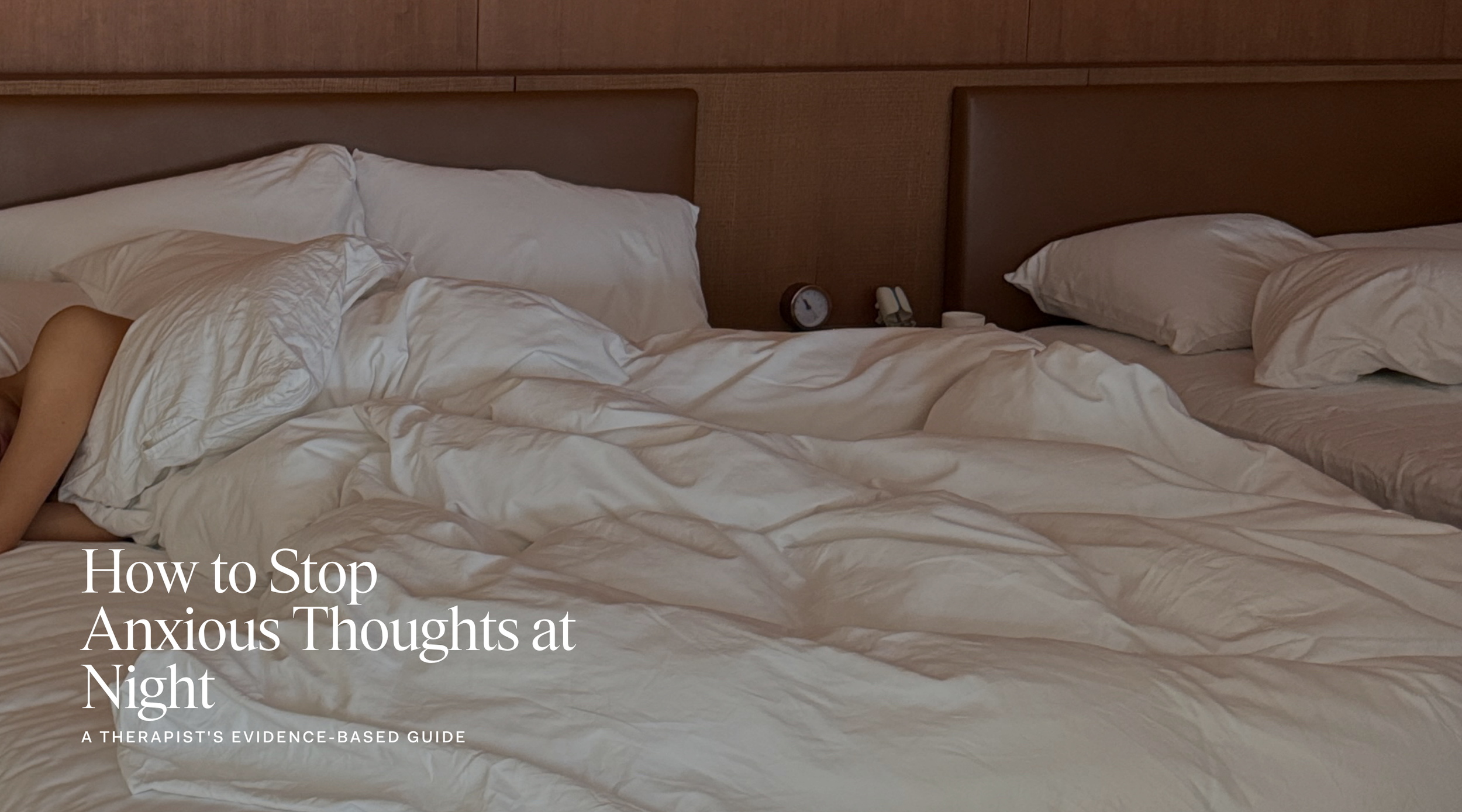How to Stop Anxious Thoughts at Night: A Therapist's Evidence-Based Guide
It's 2am. You're exhausted, but your mind won't stop replaying that conversation from three days ago. Or catastrophizing about tomorrow's meeting. Or analyzing whether you said the wrong thing in a text you sent six hours ago.
If you've ever googled "how to calm anxious thoughts" or "how to stop anxious thoughts at night," you're far from alone. These are among the most searched mental health queries online—and for good reason. According to the Anxiety and Depression Association of America (ADAA), over 50% of adults report that their anxiety levels affect their ability to fall asleep at night.
But here's what most articles won't tell you: your anxious thoughts aren't a character flaw. They're a pattern—one that can be understood, interrupted, and eventually rewired.
As a Licensed Clinical Mental Health Counselor specializing in anxiety and evidence-based care, I've spent years helping high-achieving women break free from the anxious thought cycle. In this guide, I'll walk you through exactly what's happening during those sleepless nights—and what you can actually do about it.
What Are Anxious Thoughts? (And Why Do They Feel So Real?)
Anxious thoughts are automatic mental responses to perceived threats—real or imagined. They're your brain's way of trying to keep you safe by anticipating danger, solving problems before they happen, or preventing social rejection.
Common examples include:
"I'm going to mess up this presentation and everyone will think I'm incompetent"
"They haven't texted back. I must have said something wrong"
"What if I can't fall asleep and I'm exhausted tomorrow?"
"Everyone at dinner could tell I was anxious"
"I'll never figure this out"
Here's what makes anxious thoughts so powerful: they feel like facts. Your body responds with physiological arousal (racing heart, shallow breathing, tension) whether the threat is real or imagined. This is why you can't simply "think positive" or "just relax" your way out of anxiety.
The Cognitive Distortions Behind Anxious Thinking
In Cognitive Behavioral Therapy (CBT), we identify specific patterns called cognitive distortions—systematic errors in thinking that fuel anxiety:
Catastrophizing: Jumping to the worst-case scenario ("If I make one mistake, I'll lose my job")
Mind reading: Assuming you know what others think ("She definitely thinks I'm annoying")
All-or-nothing thinking: Seeing situations in extremes ("If it's not perfect, it's a failure")
Overgeneralization: Taking one event and applying it broadly ("I failed once, so I always fail")
Personalization: Taking excessive responsibility for things outside your control
These distortions aren't signs of weakness. They're learned patterns—often developed in childhood as protective mechanisms—that have outlived their usefulness.
Sign up with the form below!
The CBT Framework: Understanding Your Thought Patterns
Cognitive Behavioral Therapy is the gold standard treatment for anxiety—not because it's trendy, but because decades of research prove it works. Here's the core framework:
The Event → Thought → Emotion → Behavior Cycle
Every anxious experience follows this pattern:
EVENT
↓
AUTOMATIC THOUGHT
↓
EMOTION
↓
BEHAVIORAL RESPONSE
All of this is influenced by → CORE BELIEF
Let me show you how this plays out:
Event: You send a vulnerable text to a friend. Three hours pass with no response.
Automatic Thought: "I said too much. She thinks I'm needy. I've ruined this friendship."
Core Belief (operating beneath the surface): "If people really knew me, they'd leave."
Emotion: Anxiety, shame, regret
Behavioral Response: You check your phone every 90 seconds. You reread the message seventeen times. You start drafting a follow-up text to "fix it." You can't focus on anything else.
Why This Framework Matters
Most people try to change their emotions directly ("I shouldn't feel this way") or their behaviors ("I just need more willpower"). But emotions and behaviors are outputs—they're responses to thoughts and beliefs.
In CBT, we work upstream. We identify the automatic thoughts, examine the core beliefs driving them, and practice generating alternative interpretations based on evidence rather than fear.
This isn't about forced positivity. It's about accuracy. About seeing situations clearly instead of through the distorted lens of anxiety.
How to Calm Anxious Thoughts: 7 Evidence-Based Techniques
These strategies aren't just "tips I found on the internet." They're evidence-based interventions used in clinical practice, adapted for real life.
1. Name the Thought (Don't Become It)
Instead of: "I'm going to fail."
Try: "I'm having the thought that I'm going to fail."
This subtle language shift creates cognitive distance. You're not your thoughts—you're the person observing them. This technique, called cognitive defusion, helps you see thoughts as mental events rather than absolute truths.
2. The STOP Technique
When anxiety starts escalating:
Stop what you're doing
Take a step back (literally, if possible)
Observe what's happening inside and outside of you
Proceed mindfully
This brief interruption disrupts the automatic anxiety spiral and engages your ability to respond rather than react.
3. Challenge the Distortion
Ask yourself:
What's the evidence FOR this thought?
What's the evidence AGAINST it?
What would I tell a friend thinking this?
What's a more balanced perspective?
Example:
Thought: "Everyone at the meeting could tell I was nervous."
Challenge: "I felt nervous, but I presented all my points. Sarah even said she appreciated my insight. I'm likely overestimating how visible my anxiety was."
4. The 5-4-3-2-1 Grounding Technique
When anxiety pulls you into your head, bring yourself back to your body:
5 things you can see
4 things you can touch
3 things you can hear
2 things you can smell
1 thing you can taste
This sensory grounding technique anchors you in the present moment and can help interrupt the anxious thought spiral.
5. Scheduled Worry Time
It sounds counterintuitive, but it works: give yourself 15 minutes daily to actively worry. Write down every anxious thought. When worries pop up outside this window, tell yourself: "I'll think about that during worry time."
This practice helps contain rumination and trains your brain that not every anxious thought requires immediate attention.
6. The Downward Arrow Technique
To uncover the core belief driving your anxiety:
Take an anxious thought and ask: "If that were true, what would it mean?"
Keep asking until you hit the underlying belief.
Example:
Thought: "I'm going to mess up this presentation."
What would that mean? "People will think I'm incompetent."
What would that mean? "I'll lose credibility at work."
What would that mean? "I'll fail in my career."
What would that mean? "I'm not good enough."
There's your core belief. That's what we work with in therapy.
7. Behavioral Experiments
Test your anxious predictions:
Write down what you fear will happen
Rate how likely you think it is (0-100%)
Do the thing anyway
Record what actually happened
Compare prediction vs. reality
Over time, this builds a database of evidence that your anxiety often overestimates danger.
How to Stop Anxious Thoughts at Night, Specifically
Nighttime anxiety requires its own toolkit. Here's what actually helps.
Create a "Thought Download" Ritual
Before bed: Spend 10 minutes doing a "brain dump." Write down everything on your mind—tasks, worries, random thoughts. This signals to your brain that these items are captured and don't need to be actively held in memory.
Keep a dedicated notebook by your bed. If anxious thoughts arise after you've turned off the light, jot them down without judgment. Tell yourself: "I'll deal with this tomorrow."
The Paradoxical Approach
When you can't sleep, trying harder to sleep often makes things worse. Instead, try paradoxical intention: give yourself permission to stay awake.
Tell yourself: "It's okay if I don't sleep right now. My body knows what it needs."
Often, removing the pressure allows sleep to come naturally.
Progressive Muscle Relaxation
Systematically tense and release each muscle group:
Feet (tense 5 seconds, release)
Calves (tense, release)
Thighs (tense, release)
Continue up through your entire body
This technique reduces physical tension and gives your mind something specific to focus on besides anxious thoughts.
The "Worry Decision Tree"
When a thought wakes you up, ask:
Can I do something about this right now?
No → Practice acceptance ("This is tomorrow's problem")
Yes → Write down one action step, then let it go
Is this thought based on evidence or anxiety?
Anxiety → Use cognitive challenging
Evidence → Problem-solve tomorrow
Have I had this exact thought before?
Yes → Recognize it as a pattern, not new information
Temperature Regulation (The TIP Skill)
From Dialectical Behavior Therapy (DBT):
Temperature: Hold ice cubes, splash cold water on your face, or take a cool shower. Cold temperature can help interrupt intense anxiety.
Intense exercise: If you're wired at night, sometimes brief intense movement (jumping jacks, running in place) can help discharge anxious energy.
Paced breathing: Breathe in for 4 counts, out for 6 counts. The longer exhale can signal calm to your body.
When Anxious Thoughts Become Anxiety Disorders
Occasional anxious thoughts are normal. But sometimes anxiety crosses into clinical territory. Consider seeking professional help if:
Anxious thoughts interfere with daily functioning (work, relationships, self-care)
You're avoiding important activities due to anxiety
Physical symptoms are constant (chest tightness, GI issues, insomnia)
You're using substances to manage anxiety
Anxiety has persisted for 6+ months
You're experiencing panic attacks
You have intrusive thoughts you can't control
Common anxiety disorders include:
Generalized Anxiety Disorder (GAD)
Social Anxiety Disorder
Panic Disorder
Health Anxiety
Obsessive-Compulsive Disorder (OCD)
The good news? All of these are highly treatable with evidence-based therapy.
Working with a Therapist: What to Expect
If you've been managing anxiety alone, therapy might feel intimidating. Here's what quality CBT-based treatment actually looks like:
The First Session
We'll discuss:
Your current symptoms and how they impact your life
Your history (family, relationships, past experiences)
Your goals for therapy
How CBT works and what to expect
This is also where we begin building rapport. Despite CBT's "structured" reputation, the therapeutic relationship matters immensely. You should feel heard, respected, and safe.
Ongoing Sessions
Sessions typically follow this structure:
Brief check-in and mood monitoring
Review of homework/practice from last week
Agenda-setting (what do we focus on today?)
Skill-building or cognitive work
New homework assignment
Summary and feedback
Homework is essential in CBT. This isn't therapy where you talk for an hour and leave. We're building skills you'll use between sessions—that's where the real change happens.
What Makes My Approach Different
I work with high-achieving women who are tired of "just managing" their anxiety. My clients are successful, capable, and often perfectionistic—and their anxiety is deeply tied to those very strengths.
My practice offers:
Evidence-based interventions (CBT, DBT skills, elements of ACT)
Boutique, personalized care (not a therapy factory)
Real talk, no toxic positivity (your anxiety isn't fixed with affirmations)
Cultural attunement (understanding how race, gender, and identity intersect with mental health)
Out-of-network model (I help with insurance reimbursement via Mentaya)
Sessions range from $220-$260. I currently have availability in New York, New Jersey, Massachusetts, Florida, and South Carolina.
Frequently Asked Questions
How long does it take to stop anxious thoughts?
CBT typically shows results within 8-12 weeks, though this varies by person. You'll likely notice small shifts within the first month as you begin recognizing patterns and practicing new responses.
Can medication help with anxious thoughts?
Medication (typically SSRIs) can be helpful, especially for moderate to severe anxiety. Many of my clients use a combination of therapy and medication. I work collaboratively with psychiatrists when needed.
What's the difference between anxious thoughts and intuition?
Intuition is typically calm, clear, and consistent. Anxiety is urgent, catastrophic, and often contradicts itself. Intuition says "something feels off here." Anxiety says "everything is falling apart and it's all your fault."
Do anxious thoughts ever fully go away?
The goal isn't to eliminate anxious thoughts entirely (that's not realistic for anyone). The goal is to change your relationship with them—to observe them without being controlled by them.
About the Author
Brianna is a Licensed Clinical Mental Health Counselor (LCMHC) and founder of On Par Therapy, a boutique virtual practice serving high-achieving women across five states. She specializes in anxiety, perfectionism, and burnout using evidence-based approaches including CBT, DBT, and Motivational Interviewing. Her work has been featured in Vogue, Forbes, Time, and Bustle.
Brianna works with clients located in New York, New Jersey, Massachusetts, Florida, and South Carolina
Schedule an introduction call with Brianna here.




